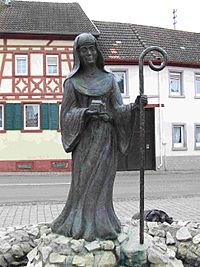Leoba facts for kids
Quick facts for kids Saint Leoba |
|
|---|---|

St. Leoba's statue in Schornsheim
|
|
| Born | ~710 Wessex, England |
| Died | 28 September 782 Schornsheim, Germany |
| Venerated in | Roman Catholic Church; Eastern Orthodox Church |
| Major shrine | Fulda |
| Feast | 28 September |
Saint Leoba (born around 710 – died September 28, 782) was an Anglo-Saxon Benedictine nun. She is known as a saint today. In 746, Leoba and other nuns left their home in Wimborne Minster, England. They traveled to Germany to help her relative, Boniface, spread Christianity.
Leoba was a very educated woman. She helped start convents (places for nuns) in Kitzingen and Ochsenfurt. She played a big part in teaching people about Christianity in that area. Many people believed Leoba performed miracles through prayer. These included saving a village from fire and protecting nuns from harm.
Contents
Early Life and Education
Leoba was born in Wessex, England. Her birth name was Leofgyth. She was the only child of older parents, Dynne and Æbbe. Her mother was related to Boniface, and her father was Boniface's friend. Leoba's mother had a dream that her child would be special and serve the church. The name "Leob" means "greatly loved."
Leoba first trained at the double monastery of Wimborne Minster. A double monastery was a place where monks and nuns lived in separate areas but shared some facilities. She was given to the care of Abbess Tetta. Later, Leoba officially became a nun there.
The nuns at Wimborne were very skilled. They were good at copying and decorating old books. They were also famous for their fine needlework called Opus Anglicanum. This embroidery often used gold and silver threads and was decorated with jewels. This beautiful English artwork was very popular across Europe.
Leoba wrote letters to Boniface, asking him to pray for her parents. Boniface later decided he needed help in Germany. He asked Abbess Tetta to send Leoba and other nuns to help him spread Christianity.
Boniface specifically asked for Leoba. He believed many people would benefit from her holy life and example. Leoba once had a dream about a purple thread coming from her mouth. She pulled it until it became a ball. A wise nun explained the dream. She said it meant Leoba would be a leader and a great teacher. In 748, Leoba, along with Thecla and others, went to Germany.
Life as a Missionary
Boniface started a convent for Leoba in Tauberbischofsheim. She became the abbess, which means she was the head of the convent. Boniface gave her a lot of power. She was in charge not only of her own convent but also of all the nuns working with Boniface.
In 754, Boniface was going on a trip. He gave his monastic cloak to Leoba. This showed that she was his representative while he was away.
Leoba was a very educated woman. In the years that followed, she helped start more convents. These included convents in Kitzingen and Ochsenfurt. She played a major role in teaching people about Christianity in her area. People said she could even calm a storm with her prayers.
Important church leaders, like bishops in Fulda, asked her for advice. She was the only woman allowed to enter monasteries in Fulda. There, she talked with leaders about how monasteries should be run. She was also well-liked by King Pippin III. Hildegard, who was the wife of Charlemagne, was her friend.
Later Years and Passing
In her older years, Leoba moved to an estate near Mainz in Schornsheim. King Charlemagne gave her this estate to use only for herself. She lived there with a few other Anglo-Saxon nuns.
Leoba passed away around September 28, 782. Boniface had wanted Leoba to be buried in his own tomb. However, when Leoba died, she was buried in a tomb close to his.
Miracles Attributed to Leoba
Many miracles were believed to have happened because of Leoba's prayers. These include:
- Saving a village from a fire.
- Protecting a town from a terrible storm.
- Keeping the good name of the nuns in her convent safe.
- Saving the life of a very sick nun.
After her death, people reported more miracles at Leoba's grave. For example, a man was freed from tight iron rings on his arms. Another man from Spain was cured of a twitching problem. Because of these miracles, Leoba's holy remains were moved twice to keep them safe.
Veneration as a Saint
Many miracles were linked to Leoba's prayers, and she became known as a saint. Her holy remains were moved twice. Today, they are behind an altar in a church near Fulda. About 50 years after her death, a writer named Rudolf of Fulda wrote her life story, called Vita Leobae. He did this when her remains were moved for the second time.
Her special day in the Roman Catholic Church is September 28. There is even a beer and mushroom soup named after Saint Leoba!
See also
- Saint Leoba, patron saint archive

